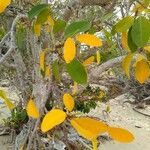Trees deciduous, up to 15 m tall; branches lenticellate, glabrous. Leaves alternate throughout; stipules ovate, 1.5-2 mm; petiole 1.5-3 cm; leaf blade elliptic or broadly elliptic, rarely ovate-oblong, 4.5-10 × 3-5 cm, subleathery, base obtuse or broadly cuneate, margin entire or indistinctly serrulate, with 2 distinct glands at base near junction with petiole, apex obtusely acuminate; midvein stout, concave adaxially, convex abaxially, lateral veins 10-13, arcuately ascending steeply and running close to edge some distance before terminating. Flowers dioecious, in axillary, solitary or double racemelike thyrses; male inflorescences 3-4.5 cm, dense and catkinlike, female ones shorter. Male flowers 1 per bract; bracts broadly ovate, fleshy, ca. 2 × 2 mm, base inside 2-glandular, branchlets lanceolate; sepals linear-acuminate, ca. 1.2 mm; stamens usually exceeding sepals. Female flowers: bracts and bracteoles as in male; pedicels slightly longer than male ones (elongating to 5 mm in fruit); sepals broadly ovate or triangular, slightly connate at base, ca. 1.4 × 1 mm; ovary ovoid; stigmas, ca. 3 mm, free, revolute at apex. Capsules globose, trisulcate, 7-8 × ca. 10 mm; cocci ovoid, rostrate at apex. Seeds globose, ca. 4 mm in diam. Fl. and fr. Jan-Sep. 2n = 140.
More
Shrub or small tree to 10 m high, evergreen. Stipules lanceolate-triangular, 0.8–1 mm long. Leaves discolorous; petiole 6–37 mm long; lamina elliptic, or obovate, 13–150 mm long, 10–80 mm wide; base cuneate, rounded; margins crenate with 11–14 short teeth per side of midrib; tip acuminate, acute, notched or rounded; lateral veins 7–17. Male flowers ± sessile; sepals 3, linear-lanceolate, 0.4–1.2 mm long; stamens 3. Female flowers: pedicels 1–2 mm long; sepals 3, lanceolate, 0.8–2 mm long; styles 3, 1–1.5 mm long. Fruit depressed-globose, 4–5 mm long, 5–7 mm diam. Seeds globose-ovoid, 4–5 mm long, 2–4 mm wide. [See also Green (1994).]






